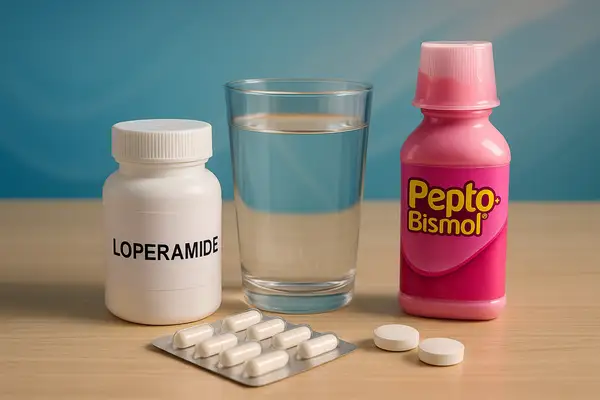Let’s be honest—nobody likes to talk about loose stools. But digestive upsets happen to everyone, and knowing what causes them (and how to manage them) can make a big difference in how you feel day-to-day. Loose stools may be a passing inconvenience, or they may signal an underlying condition that needs attention. This article explores the main reasons for loose stools, practical home care, medical treatments, and expert advice on when to see a doctor.
What Exactly Are Loose Stools?
Loose stools refer to bowel movements that are softer, wetter, and more frequent than usual. While not as severe as diarrhea, they often signal irritation or inflammation in the gastrointestinal tract. The Bristol Stool Scale is a handy tool used by doctors to classify stool types, from Type 1 (hard pellets) to Type 7 (watery, no solid pieces). Types 5–7 typically indicate looseness.
| Bristol Type | Appearance | Possible Meaning |
|---|---|---|
| 1–2 | Hard lumps | Constipation |
| 3–4 | Normal | Healthy stool |
| 5–7 | Soft to watery | Loose stools or diarrhea |
Mild looseness for a day or two isn’t alarming, especially after dietary changes or mild stress. But if stools remain loose for more than three days, or if other symptoms appear—like fatigue, abdominal pain, or dehydration—it’s time to pay attention. According to ⧉ clinical observations, persistent loose stools often point to underlying digestive imbalance or infection that needs medical evaluation.
Common Causes of Loose Stools
There are many reasons you might experience loose stools. Some are temporary, others chronic:
- Dietary choices: Too much greasy food, caffeine, or artificial sweeteners can irritate the gut. Lactose intolerance is another common cause. Studies by ⧉ Johns Hopkins Medicine show that individuals with mild lactose intolerance can experience loose stools within 30–60 minutes after consuming dairy.
- Infections: Bacterial (E. coli, Salmonella), viral (norovirus), or parasitic (Giardia) infections may lead to acute intestinal upset. Clinical data suggest these infections are responsible for nearly 60% of short-term loose stool episodes in adults.
- Medications: Antibiotics disrupt gut flora balance. Magnesium-containing antacids and certain blood pressure drugs may also cause looser bowel movements.
- Digestive disorders: Chronic issues such as irritable bowel syndrome (IBS), Crohn’s disease, or celiac disease often feature loose stools as a primary symptom.
- Stress and hormones: The gut-brain connection is powerful—emotional distress alters motility and fluid absorption in the intestines.
Case Example: A 35-year-old man from Texas developed intermittent loose stools after switching to a high-protein, low-carb diet. Reducing fatty meats and adding soluble fiber resolved his symptoms within a week.
How Doctors Diagnose the Cause
Determining the reason for loose stools involves several diagnostic procedures. These tests vary in accuracy, cost, and complexity. The table below summarizes the most commonly used diagnostic methods in U.S. clinical practice.
| Diagnostic Test | Accuracy | Average Cost (USD) |
|---|---|---|
| Stool Test | 8/10 | $25–100 |
| Blood Test | 7/10 | $30–200 |
| Ultrasound / CT Scan | 9/10 | $300–800 |
| Colonoscopy | 10/10 | $1,000–3,000 |
Descriptions of Diagnostic Methods:
1. Stool Test:
A stool sample is collected to detect infections, parasites, or microscopic traces of blood. The test is simple, noninvasive, and typically provides results within 24–48 hours. Patients are advised to avoid antibiotics or iron supplements two days prior to testing to prevent false readings. It is often the first-line investigation for unexplained loose stools.
2. Blood Test:
This standard laboratory test measures inflammation markers, electrolyte levels, and nutrient absorption indicators. A fasting period of 6–8 hours may be requested. It helps identify dehydration, anemia, or systemic conditions that contribute to chronic diarrhea. It is quick, widely available, and often used in combination with stool analysis.
3. Ultrasound / CT Scan:
These imaging techniques provide visual assessment of the abdominal organs. An ultrasound uses sound waves, while a CT scan combines multiple X-rays for detailed cross-sectional images. Patients are usually asked not to eat for several hours before the test. These methods are used to identify inflammation, bowel wall thickening, or other structural abnormalities.
4. Colonoscopy:
This endoscopic procedure allows direct visualization of the colon using a flexible tube with a camera. Preparation involves a clear-liquid diet and bowel cleansing the day before the test. It is performed under mild sedation and can detect inflammation, polyps, ulcers, or cancerous changes. Because it allows for biopsy collection, it is considered the most comprehensive diagnostic method for chronic or unexplained intestinal symptoms.
Reyus Mammadli, medical consultant, highlights that diagnostic precision depends on proper preparation and timing. “Even the best test won’t tell the full story unless the patient follows the prep guidelines carefully,” he notes. ⧉
How to Manage Loose Stools at Home
For mild cases, lifestyle and dietary adjustments are often effective:
- Hydration is key: Frequent stools cause fluid loss. Replenish with water, diluted fruit juice, or electrolyte solutions.
- BRAT diet: Bananas, rice, applesauce, and toast are bland and easy to digest.
- Avoid irritants: Skip caffeine, alcohol, fatty foods, and dairy if lactose sensitive.
- Eat in moderation: Smaller meals are easier for the digestive tract to process.
A report from ⧉ Johns Hopkins confirms that following a bland diet and maintaining hydration can restore stool consistency in 24–48 hours for most mild cases.
| Foods to Avoid | Foods to Try |
|---|---|
| Fried foods, coffee, milk | Rice, bananas, oatmeal, boiled potatoes |
| Spicy sauces, alcohol | Plain yogurt, applesauce, toast |
As Americans like to say, “Cut back on the greasy stuff—your gut will thank you!”
Over-the-Counter (OTC) Medications
Over-the-counter (OTC) medications are often the first line of relief for mild or short-term loose stools when no infection or severe symptoms are present. They help regulate bowel movement frequency, reduce intestinal irritation, and improve stool consistency. Understanding how each drug works—and when not to use it—is key to safe and effective treatment.
1. Loperamide (Imodium®)
- Mechanism: Slows the movement of the intestines, allowing more time for water absorption. This leads to firmer stools and fewer trips to the bathroom.
- Typical dosage: Adults usually start with 4 mg (two 2-mg tablets) after the first loose stool, then 2 mg after each subsequent episode (max 8 mg/day OTC, or 16 mg/day under physician supervision).
- When to use: Ideal for traveler’s diarrhea or IBS-related looseness without fever or blood.
- Caution: Do not use if there’s fever, bloody stool, or suspected bacterial infection, as it can trap bacteria inside and worsen the condition.
- Popular U.S. brands: Imodium® A-D, Kirkland Anti-Diarrheal®, Equate Anti-Diarrheal®.
2. Bismuth Subsalicylate (Pepto-Bismol®, Kaopectate®)
- Mechanism: Coats and soothes the intestinal lining, reducing inflammation and inhibiting certain bacteria. It also helps with nausea and stomach discomfort that often accompany loose stools.
- Typical dosage: 30 mL or two tablets every 30–60 minutes as needed, not exceeding 8 doses/24 hours.
- When to use: Good choice for mild infectious diarrhea, traveler’s diarrhea, or gastric upset linked to diet.
- Side effects: May temporarily darken the tongue or stool—harmless but notable. Avoid in people allergic to aspirin or those taking blood thinners.
- Popular brands: Pepto-Bismol®, Kaopectate®, GoodSense® Bismuth Subsalicylate.
3. Combination Formulas
Some OTC products combine probiotics and antidiarrheal ingredients to restore gut balance while controlling symptoms. For example, Imodium® Multi-Symptom Relief includes simethicone to reduce gas and cramps, while Culturelle® Digestive Daily Probiotic + Imodium® packs both microbial and motility-control support.
These combinations are generally well tolerated but should be used no longer than 48 hours unless directed by a doctor.
Important precautions:
- Avoid self-treating diarrhea that lasts more than 48–72 hours or includes fever, blood, or severe pain.
- Stay hydrated—OTC drugs reduce stool frequency but don’t replace lost fluids.
- Children under 12 years old should only use OTC antidiarrheals under pediatric supervision.
- Pregnant or breastfeeding individuals should consult their clinician before use.
Clinical data compiled by ⧉ Drugs.com and U.S. gastroenterology guidelines show OTC medications relieve symptoms within 6–12 hours for uncomplicated cases and shorten mild diarrheal episodes by up to 30% when combined with rehydration and dietary adjustment.
Reyus Mammadli, medical consultant, advises: “OTC medications are like putting your digestive system on pause—it gives your body time to recover, but it’s not a reset button. If the symptoms hit replay, it’s time to call your doctor.”
Probiotics and Gut Health
Probiotics are living microorganisms that, when consumed in adequate amounts, help maintain or restore a healthy balance of bacteria in the gut. They don’t simply replace what was lost—they actively interact with intestinal cells, digestive enzymes, and the immune system to improve the gut’s resilience.
How probiotics work:
- They repopulate the intestines after an imbalance caused by antibiotics, infection, or poor diet.
- They compete with harmful bacteria for nutrients and space, reducing the growth of pathogens.
- They support the intestinal barrier, helping to prevent toxins and bad microbes from leaking into the bloodstream.
- They stimulate local immunity, promoting anti-inflammatory processes that calm irritated intestines.
Unlike antibiotics, probiotics do not act as a one-time treatment; they are part of a restoration program that usually lasts from two to six weeks depending on the cause of loose stools. Some people use them preventively, especially during or after antibiotic therapy, or when traveling to new regions.
Treatment plan and reliability:
- Acute loose stools (e.g., after antibiotics): Take probiotics daily for 10–14 days to restore flora.
- Chronic bowel imbalance (IBS, recurring diarrhea): Continuous supplementation for at least 4–6 weeks is advised, then reassess. ⧉
- Maintenance phase: Consuming probiotic-rich foods (like yogurt and kefir) 3–4 times a week helps maintain balance.
Clinical studies by ⧉ NIH and other U.S. research institutions show probiotics reduce the duration of antibiotic-associated diarrhea by 40–60% and improve stool consistency within 3–5 days of starting therapy.
Popular probiotic brands in the U.S.:
- Culturelle® Digestive Daily Probiotic (contains Lactobacillus rhamnosus GG) — widely used for antibiotic-related diarrhea.
- Florastor® (contains Saccharomyces boulardii CNCM I-745) — a yeast-based probiotic effective for infection-related diarrhea.
- Align® Probiotic (contains Bifidobacterium 35624) — beneficial for IBS and long-term gut health.
- Garden of Life Dr. Formulated Probiotics® — multi-strain supplement often used for preventive gut support.
For those preferring dietary sources, opt for live-culture yogurts (e.g., Activia®, Chobani® with probiotics), kefir, sauerkraut, and kimchi. These foods provide ongoing low-dose exposure to beneficial bacteria and complement capsule-based supplements.
Case Example: A 42-year-old woman from California reported normalized digestion after two weeks on Culturelle®. She continued with yogurt and kefir three times weekly for a month, maintaining steady bowel regularity.
Reyus Mammadli, medical consultant, notes that probiotic therapy is most reliable when the cause of loose stools is flora imbalance rather than active infection. “Think of probiotics as gardeners for your gut—they don’t just visit once; they stay to nurture balance.”
When to Seek Medical Help
Loose stools are often short-lived, but certain thresholds of intensity, duration, or combinations of symptoms mean it’s time to involve a professional. The guide below translates medical red flags into plain-English decision points so a person can confidently choose care.
Call a healthcare professional within 24 hours if any one of the following applies:
- Fever: Temperature >101°F (38.3°C) that lasts more than 24–48 hours, or any fever >102°F (38.9°C) at any time. Persistent or higher fevers increase the likelihood of infection that shouldn’t be self-treated with antidiarrheals. ⧉
- Frequency/volume: ≥6 loose stools in 24 hours or diarrhea that persists >72 hours despite home measures (hydration, bland diet). This threshold is associated with higher dehydration risk and may indicate bacterial or protozoal causes. ⧉
- Dehydration signs (any of the following): very dark urine, urinating fewer than 3 times/day (adults) or minimal urine in >8 hours (children), dry mouth, orthostatic dizziness (light-headed when standing), or marked fatigue/confusion. These are clinical markers that fluids and electrolytes are insufficient. ⧉
- Severe abdominal pain lasting >2 hours or localized/worsening pain (especially right-lower-quadrant or with rebound). Severe, focal, or escalating pain can signal inflammation beyond simple gastroenteritis. ⧉
Seek urgent or emergency care (same day) if any of the following occurs:
- Blood in stool (bright red), black/tarry stool, or visible pus. These are not “wait-and-see” symptoms. Do not use loperamide in these scenarios. ⧉
- Inability to keep liquids down for >24 hours, ongoing vomiting, or signs of rapidly worsening dehydration (confusion, fainting). ⧉
- Fever ≥104°F (40°C) at any time. ⧉
- Red-flag combinations, e.g., moderate fever (100.4–101°F / 38.0–38.3°C) + ≥6 loose stools/day, or diarrhea >48 hours + new severe abdominal pain.
Special populations (lower threshold to seek care):
- Age <5 years or ≥65 years: Call a clinician earlier for any dehydration signs, fever >100.4°F (38.0°C) lasting >24 hours, or diarrhea >48 hours. Pediatric cues include no tears, sunken eyes, and no urine in >8 hours. ⧉
- Pregnancy: Contact your OB/GYN if diarrhea lasts >48 hours, there’s fever, blood in stool, ≥6 loose stools in 24 hours, or you can’t keep fluids down. Some infections are pregnancy-specific risks. ⧉
- Weakened immunity (chemotherapy, transplant meds, advanced HIV): Seek care promptly for any fever or symptoms beyond mild, short-lived diarrhea.
Quick reference: thresholds and actions
| Symptom/Scenario | Threshold that tips the scale | Recommended action |
|---|---|---|
| Fever | >101°F (38.3°C) >24–48h, or any >102°F (38.9°C) | Call clinician within 24h |
| Stool frequency | ≥6 loose stools/24h or symptoms >72h | Call clinician within 24h |
| Blood/black stools | Any visible blood, black/tarry, or pus | Same-day urgent/ER; avoid loperamide |
| Dehydration | Dark urine, urinating <3×/day (adults) or none >8h (kids), dizziness on standing | Same-day urgent evaluation if not improving with oral rehydration |
| Severe pain | Constant >2h, focal/worsening, with guarding/rebound | Same-day urgent evaluation |
| Vomiting + diarrhea | Cannot keep fluids down >24h | Same-day urgent/ER |
Practical note (OTC caveat): Avoid loperamide or bismuth subsalicylate if there is fever >101°F (38.3°C) with bloody stools or suspected invasive infection; these can worsen some bacterial illnesses. ⧉
Expert insight: Reyus Mammadli, medical consultant, recommends a simple “two‑strike rule”: if any one red flag appears or two moderate issues happen together (e.g., temperature 100.6°F (38.1°C) + ≥6 stools, or 48 hours of symptoms + new dizziness), stop self‑care and call your clinician. In plain speak: if your gut is throwing shade and the dashboard lights are blinking, don’t try to power through—get help.
Editorial Advice
If your digestive system feels like it’s running a marathon, slow it down and listen to it. Don’t ignore persistent loose stools—early evaluation can prevent bigger problems later. Keep a food and symptom diary, stay hydrated, and nourish your body with balanced, whole foods.
Expert note from Reyus Mammadli: Chronic digestive symptoms deserve attention, not embarrassment. Discussing them openly with your physician can lead to effective, modern treatments.
And remember—your gut deserves VIP treatment. Treat it kindly, and it will treat you kindly back!
About the Author
Reyus Mammadli is the author of this health blog since 2008. With a background in medical and biotechnical devices, he has over 15 years of experience working with medical literature and expert guidelines from WHO, CDC, Mayo Clinic, and others. His goal is to present clear, accurate health information for everyday readers — not as a substitute for medical advice.








This was very informative, but really does not answer my question about my 88 year old moms condition. She has been having loose stools for a LONG time now. We both eat a very nice variety of foods ….. bran…. veggies. etc… Moms doctor Rx’ed A soluble Fiber and we tried SEVERAL ……. with no poss. results. And Mom is really tired of her condition. Thx for any help.